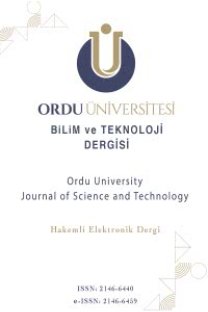Cs Simetrisindeki Trikarbonil Komplekslerinin Kuvvet Sabitlerinin Yeni Bir Metot ile Analizi
Metal karbonil kompleksleri, CO-ayrımlı kuvvet alanları, Kuvvet sabitleri
A New Method for Analyzing the Force Constants of Tricarbonyl Complexes with CS Symmetry
___
- 1. Applegate J C, Okeowo M K, Erickson N R, Neal B M, Berrie C L, Gerasimchuk N M & Barybin M V (2016). First π-linker featuring mercapto and isocyano anchoring groups within the same molecule: synthesis, heterobimetallic complexation and self-assembly on Au(111). Chemical Science. :1–8.
- 2. Bour P, Kubelka J & Keiderling T A (2000). Simulations of oligopeptide vibrational CD: Effects of isotopic labeling. Biopolymers 53:380–395.
- 3. Braterman P S, Harrill R W & Kaesz H D (1964). Spectroscopic Studies of Isotopically Substituted Metal Carbonyls. Journal of the American Chemical Society 2734(50):2851–2855.
- 4. Brimm E O, Lynch M A & Sesny W J (1954). Preparation and Properties of Manganese Carbonyl. Journal of the American Chemical Society 76(6):3831–3835.
- 5. Carpenter A E, Mokhtarzadeh C C, Ripatti D S, Havrylyuk I, Kamezawa R, Moore C E, Rheingold A L & Figueroa J S (2015). Comparative measure of the electronic influence of highly substituted aryl isocyanides. Inorganic Chemistry 54(6):2936–2944.
- 6. Fish R H & Jaouen G (2003). Bioorganometallic chemistry: Structural diversity of organometallic complexes with bioligands and molecular recognition studies of several supramolecular hosts with biomolecules, alkali-metal ions, and organometallic pharmaceuticals. Organometallics 22(d):2166–2177.
- 7. Ghaffar T, Adams H, Maitlis P M, Sunley G J, Baker M J & Haynes A (1998). Spectroscopic identification and reactivity of [Ir(CO)3I2Me], a key reactive intermediate in iridium catalysed methanol carbonylation. Chemical Communications 2:1023–1024.
- 8. Gorfti A, Salmain M, Jaouen G, McGlinchey J, Bennouna A & Mousser A (1996). Covalent and selective labeling of proteins with heavy metals. Synthesis, X-ray structure, and reactivity studies of N-succinimidyl and N-sulfosuccinimidyl ester organotungsten complexes. Organometallics 15(10):142–151.
- 9. Hillard E A & Jaouen G (2011). Bioorganometallics: Future trends in drug discovery, analytical chemistry, and catalysis. Organometallics 30(5):20–27.
- 10. Kaya C, Karakaş D & Üstün E (2007). A new approach to predicting the carbonyl stretching frequencies of Co2(CO)8 with D3d symmetry. Indian Journal of Chemistry 46A:1388–1392.
- 11. Kendall A J, Zakharov L N & Tyler D R (2016). Steric and Electronic Influences of Buchwald-Type Alkyl-JohnPhos Ligands. Inorganic Chemistry 55(6):3079–3090.
- 12. Knör G & Monkowius U (2011). Photosensitization and photocatalysis in bioinorganic, bio-organometallic and biomimetic systems. Inorganic Photochemistry 63:235-289.
- 13. Morisaki Y, Chen H & Chujo Y (2004). Synthesis and characterization of organometallic conjugated polymers containing tricarbonyl(arene)chromium unit and platinum. Journal of Organometallic Chemistry 689:2684–2689.
- 14. Motterlini R, Clark J E, Foresti R, Sarathchandra P, Mann B E & Green C J (2002). Carbon monoxide-releasing molecules: characterization of biochemical and vascular activities. Circulation Research 90:E17–E24.
- 15. Mula B, Beaumont A J, Doyle K O, Gallagher M L & Rooney A D (1999). Charge Transfer Complexes of Arebe-molybdenum-tricarbonyl as heterogenous metathesis catalysts for the polymerization of Phenylacetylene. Journal of Molecular Catalysis 148:23–28. 16. Salmain M, Vessiere A, Varenne A, Brossier P & Jaouen G (1999). A new application of bioorganometallics: the first simultaneous triple assay by the carbonylmetalloimmunoassay (CMIA) method. Journal of Organometallic Chemistry 589:92–97.
- 17. Schatzschneider U (2014). Novel lead structures and activation mechanisms for CO-releasing molecules (CORMs). British journal of Pharmacology 172:1638-1650.
- 18. Üstün E, Özgür A, Coşkun K A, Düşünceli S D, Özdemir İ & Tutar Y (2017). Anticancer activities of manganese-based photoactivatable CO-releasing complexes (PhotoCORMs) with benzimidazole derivative ligands. Transition Metal Chemistry 42(4):331–337.
- 19. Üstün E, Ayvaz M Ç, Çelebi M S, Aşcı G, Demir S & Özdemir İ (2016). Structure, CO-releasing property, electrochemistry, DFT calculation, and antioxidant activity of benzimidazole derivative substituted [Mn(CO)3(bpy)L]PF6 type novel manganese complexes. Inorganica Chimica Acta 450:182–189.
- 20. Üstün E & Kaya C (2010). Calculating the CO-factored force constants of tricarbonyl complexes with Cs symmetry. Journal of Organometallic Chemistry 695(19–20):2273–2276.
- ISSN: 2146-6440
- Yayın Aralığı: 2
- Başlangıç: 2011
- Yayıncı: ORDU ÜNİVERSİTESİ
Fındık Zuruf Kompostunun Yeşil Alan Tesisinde Örtü Materyali Olarak Kullanımı
Damla BENDER ÖZENÇ, Merve ŞAHİN
Tersinir Bir Altbloğa Sahip Blok Parçalanmiş Matrislerin Grup İnversleri İçin Bazı İfadeler
CoCrMo Tibial Komponentin Karbür Takım ile İşlenmesinde Yüzey Özelliklerinin Araştırılması
Erkan BAHÇE, Mehmet Sami GÜLER, Ender EMİR, Cihan ÖZEL
Akdeniz'de İki Farklı Solea solea Popülasyonunda Otolit Kütle Asimetrisinin Karşılaştırılması
Serdar YEDİER, Derya BOSTANCI, Seda KONTAŞ, Gülşah KURUCU, Nazmi POLAT
Çim Alanlarında Mantar Kompostunun Örtü Materyali Olarak Kullanımı
Yunus Emre DOYRAN, Faruk ÖZKUTLU, Mehmet AKGÜN, Özlem ETE
Derya BOSTANCI, Dilek TÜRKER, Serdar YEDİER, Seda KONTAŞ, Gülşah KURUCU
Cs Simetrisindeki Trikarbonil Komplekslerinin Kuvvet Sabitlerinin Yeni Bir Metot ile Analizi
İletken Poli (Vinilferrosen) Filmi İçerisinde Prusya Mavisinin Elektrokimyasal Sentezi
